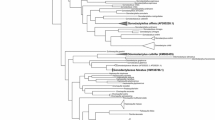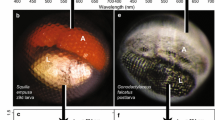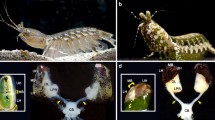Abstract
Anatomical dimensions of individual ommatidia from various regions in the eyes of six species of stomatopod have been measured. Using these measurements, estimates of the sensitivity and acceptance angle of each ommatidium were calculated. The relationship between sensitivity distribution in various eye regions and habitat was examined. There is a good correlation between the sensitivity of eyes in the six species examined and their habitat or activity cycle. Animals living in deeper or more turbid water, or which are often active at night possess eyes with relatively high sensitivity. Ommatidia in six-row mid-bands are more sensitive than those in surrounding eye regions. This is achieved by enlarging ommatidial size or decreasing focal length. Increased light capture is necessary in these rows as they contain dense intrarhabdomal filters and tiered rhabdoms which drastically attenuate light as it passes down the rhabdom. Acute zone facets are larger, also for additional sensitivity. The way the image is sampled was studied by comparing acceptance angles to inter-ommatidial angles, measured previously. In most eye regions of most eyes these angles are matched. Where this is not the case (in the mid-band, near mid-band regions and the edge of the eye) an explanation can be found in the function of the region involved, or that of the closely adjacent regions.
Similar content being viewed by others
Abbreviations
- AZ:
-
Acute Zone
- MB:
-
Mid-band
- R8:
-
Rhabdomere 8
- R1-7:
-
Rhabdomeres 1–7
- DR1-7:
-
Distal rhabdomeres 1–7 (Marshall et al. 1991)
- PR 1–7:
-
Proximal rhabdomeres 1–7
- F1:
-
Proximal filter (Marshall et al. 1991)
- F2:
-
Distal filter
- DH:
-
Dorsal hemisphere
- VH:
-
Ventral hemisphere
- D :
-
Corneal facet diameter, as MB facets are asymmetrical, values for width and height of each facet are given
- f :
-
Focal length of each ommatidium, estimated from the centre of the corneal lens to the tip of the rhabdom
- a :
-
Diameter of the aperture at the rhabdom tip. This is often less than the rhabdom diameter
- l :
-
Length of rhabdom or tier
- d :
-
Diameter of rhabdom or filter, maximum for each tier
- Δρ:
-
Geometrical acceptance angle (a/f×57.3) of each ommatidium
- ΔΦh :
-
Horizontal inter-ommatidial angle, between facets along a row
- ΔΦv :
-
Vertical inter-ommatidial angle, between rows
- S :
-
Sen-sitivity of a rhabdom (in μm2) calculated as: S=(π/4)2(D/f)2d2(1−e−kl)
- k=0.008:
-
the approximate fraction of light absorbed, at receptor peak wavelength, in 1 μm of rhabdom (Cronin and Marshall 1989b)
- R:
-
Resolving power=1/2ΔΦaverage
- Rh :
-
Horizontal resolving power=1/2ΔΦh
- Rv :
-
Vertical resolving power=1/2ΔΦv
- NeMB:
-
Near mid-band ommatidia
- G.c. :
-
Gonodactylus chiragra
- O.s. :
-
Odontodactylus scyllarus
- H.e. :
-
Hemisquilla ensigera
- L.t. :
-
Lysiosquilla tredecimdentata
- C.s. :
-
Coronis scolopendra
- O.o. :
-
Oratosquilla solicitans
References
Abbott BC, Manning RB, Schiff H (1984) An attempt to correlate pseudopupil sizes in stomatopod crustaceans with ambient light conditions and behavior patterns. Comp Biochem Physiol 78A(3): 419–426
Caldwell RL, Dingle H (1976) Stomatopods. Sci Am 234(1): 80–89
Cronin TW, Marshall NJ (1989a) A retina with at least ten spectral types of photoreceptors in a mantis shrimp. Nature (Lond) 339:137–140
Cronin TW, Marshall NJ (1989b) Multiple spectral classes of photoreceptors in the retinas of gonodactyloid stomatopod crustaceans. J Comp Physiol A 166:261–275
Cronin TW, Marshall NJ, Caldwell RL (1993) Photoreceptor spectral diversity in the retinas of squilloid and lysiosquilloid stomatopod crustaceans. J Comp Physiol A 172:339–350
Dahmen H (1991) Eye specialisation in waterstriders: an adaptation to life in a flat world. J Comp Physiol A 169:623–632
Denton EJ (1990) Light and vision at depths greater than 200 meters. In: Herring PJ, Campbell AK, Whitfield M, Maddock L (eds) Light and life in the sea. Cambridge Univ Press, Cambridge, pp 127–148
Franceschini N (1975) Sampling of the visual environment by the compound eye of the fly: fundamentals and applications. In: Snyder AW, Menzel R (eds) Photoreceptor optics. Springer, Berlin Heidelberg New York, pp 98–125
Hardie RC (1986) The photoreceptor array of the dipteran retina. Trends Neurosci 9(9): 419–423
Hardie RC (1988) The eye of the mantid shrimp. Nature (Lond) 333:499–500
Hateren JH van, Hardie RC, Rudolph A, Laughlin SB, Stavenga DG (1989) The bright zone, a specialised dorsal eye region in the male blowfly Chrysomyia megacephala. J Comp Physiol A 164:297–308
Horridge GA (1978) The separation of visual axes in apposition compound eyes. Phil Trans R Soc Lond B 285:1–59
Jerlov NG (1976) Marine optics. Elsevier, Amsterdam London New York
Land MF (1981) Optics and vision in invertebrates. In: Autrum H (ed) Handbook of Sensory Physiology VII/6B. Springer, Berlin Heidelberg New York, pp 471–539
Land MF (1984) Crustacea. In: Ali MA (ed) Photoreception and vision in invertebrates. Plenum, New York, pp 401–438
Land MF (1985) The morphology and optics of spider eyes. In: Barth FG (ed) Neurobiology of arachnids. Springer, Berlin Heidelberg New York, pp 53–78
Land MF (1989a) Variations in the structure and design of compound eyes. In: Stavenga DG, Hardie RC (eds) Facets of vision. Springer, Heidelberg Berlin, pp 90–111
Land MF (1989b) The eyes of hyperiid amphipods: relations of optical structure to depth. J Comp Physiol A 164:751–762
Land MF (1990) Optics of the eyes of marine animals. In: Herring PJ, Campbell AK, Whitfield M, Maddock L (eds) Light and life in the sea. Cambridge Univ Press, Cambridge, pp 149–166
Land MF, Burton FA (1979) The refractive index gradient in the crystalline cones of the eyes of a euphausid crustacean. J Exp Biol 82:395–398
Levine JS, MacNichol EF Jr (1982) Colour vision in fishes. Sci Am 246(2): 140–149
Lythgoe JN (1979) The ecology of vision. Clarendon Press, Oxford
Lythgoe JN (1991) Evolution of visual behaviour. In: Cronly-Dillon JR, Gregory RL (eds) Evolution of the eye and visual system. Vision and visual dysfunction. Volume 2. Macmillan, pp 3–14
Marshall NJ (1988) A unique colour and polarization vision system in mantis shrimps. Nature (Lond) 333:557–560
Marshall NJ, Land MF (1993) Some optical features of the eyes of Stomatopods. I. Eye shape, optical axes and resolution. J Comp Physiol A 173:565–582
Marshall NJ, Land MF, King CA, Cronin TW (1991a) The compound eyes of mantis shrimps (Crustacea, Hoplocarida, Stomatopoda). I. Compound eye structure: the detection of polarised light. Phil Trans R Soc Lond B 334:33–56
Marshall NJ, Land MF, King CA, Cronin TW (1991a) The compound eyes of mantis shrimps (Crustacea, Hoplocarida, Stomatopoda). II. Colour pigments in the eyes of stomatopod crustaceans: polychromatic vision by serial and lateral filtering. Phil Trans R Soc Lond B 334:57–84
Nilsson D-E (1989) Optics and evolution of the compound eye. In: Stavenga DG, Hardie RC (eds) Facets of vision. Springer, Heidelberg Berlin, pp 30–73
Nilsson D-E, Odselius R (1983) Regionally different optical systems in the compound eye of the water-flea Polyphemus (Cladocera, Crustacea). Proc R Soc Lond B 217: 163–175
Rossell S (1979) Regional differences in photoreceptor performance in the eye of the praying mantis. J Comp Physiol 131:95–112
Schiff H, Abbott BC (1987) Shape, structure and optics of the eyes of two lysiosquilloid stomatopods. J Crustacean Biol 7(1):158–170
Schiff H, Abbot BC, Manning RB (1986a) Optics, rangefinding and neuroanatomy of the eye of a mantis shrimp Squilla mantis (Linnaeus) (Crustacea: Stomatopoda Squillidae). Smiths Contr Zool 440:1–32
Schiff H, Manning RB, Abbot BC (1986b) Structure and optics of ommatidia from eyes of stomatopod crustaceans from different luminous habitats. Biol Bull 170:461–480
Schwind R (1980) Geometrical optics of the Notonecta eye: adaptations to optical environment and way of life. J Comp Physiol 140:59–68
Sherk TE (1978) Development of the compound eyes of dragonflies (Odonata). III Adult compound eyes. J Exp Zool 203:61–80
Snyder AW (1979) The physics of vision in compound eyes. In: Autrum H (ed) Comparative physiology and evolution of vision in invertebrates. (Handbook of Sensory Physiology Vol VII/6A) Springer, Berlin Heidelberg New York, pp 227–309
Snyder AW, Menzel R, Laughlin SB (1973) Structure and function of the fused rhabdom. J Comp Physiol 87:99–135
Vivroux M, Schönenberger N (1981) Adaptive mechanisms in the compound eye of Squilla mantis (Crustacea, Stomatopoda). Zoomophology 97:17–30
Wehner R (1989) Neurobiology of polarisation vision. Trends Neurosci 12 (9): 353–359
Zeil H (1983) Sexual dimorphism in the visual system of flies: the compound eyes and neural superposition in Bibionidae (Diptera). J Comp Physiol 150:379–393
Zeil J, Nalbach G, Nalbach H-O (1986) Eyes, eye stalks and the visual world of semi-terrestrial crabs. J Comp Physiol A 159:801–811
Zeil J, Nalbach G, Nalbach H-O (1989) Spatial vision in a flat world: optical and neural adaptations in arthropods. In: Singh RN, Strausfeld NJ (eds) The neurobiology of sensory systems. Plenum, New York, pp 123–127
Author information
Authors and Affiliations
Rights and permissions
About this article
Cite this article
Marshall, N.J., Land, M.F. Some optical features of the eyes of stomatopods. J Comp Physiol A 173, 583–594 (1993). https://doi.org/10.1007/BF00197766
Accepted:
Issue Date:
DOI: https://doi.org/10.1007/BF00197766




